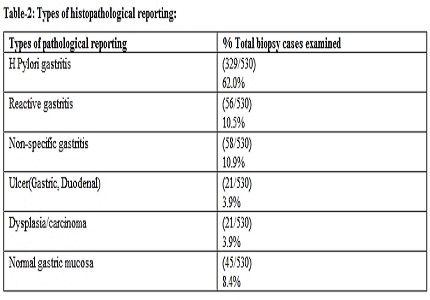A comparative study of endoscopic findings, Rapid Urease Test and Conventional Histopathology in diagnosis of Helicobacter Pylori infection
Abstract
Background: Helicobacter pylori (H pylori) related gastritis is a major health ailment in developing nations. There is high morbidity and mortality ranging from chronic gastritis to gastric malignancies. Prevalence of H pylori infection varies markedly from country to country and in a country, region to region.
Aim of the study: To evaluate the commonly available diagnostic methods, Rapid Urease Test (RUT) and conventional histopathology in diagnosis of H pylori gastritis and analyse the association of H Pylori with the development of gastrointestinal complications. Settings and design: Cross sectional prospective study conducted during the period of May 2012 to September 2014.
Material and method: The study was carried out in a tertiary medical college hospital in southern India. Patients presenting with dyspeptic symptoms were subjected to endoscopy and investigated for H pylori infection through histopathological examination and RUT of biopsy specimen. Diagnosis of H pylori was made if one or both diagnostic test results were positive.
Results: Out of 530 patients analyzed, diagnosis of H pylori was made in 329 patients (62.0%). There were significant statistical correlations of presence of endoscopic abnormalities and serious gastrointestinal complication (peptic ulcer and dysplasia/cancer) with H pylori infection. RUT had comparable predictive values to histopathology in diagnosis of H Pylori infection.
Conclusion: H Pylori is implicated with significant morbidity and mortality due to associated gastrointestinal complications. Early and precise detection by multiple cost-effective methods, bearing good patient compliance and prompt treatment is essential for prevention of serious complications.
Downloads
References
2. Jhala NC, Siegal GP, Klemm K, Atkinson BF, Jhala DN. Infiltration of Helicobacter pylori in the gastric mucosa. Am J Clin Pathol. 2003 Jan;119(1):101-7. [PubMed]
3. Lacy BE, Rosemore J. Helicobacter pylori: ulcers and more: the beginning of an era. J Nutr. 2001 Oct;131(10):2789S-2793S. [PubMed]
4. Makola D, Peura DA, Crowe SE. Helicobacter pylori infection and related gastrointestinal diseases. J Clin Gastroenterol. 2007 Jul;41(6):548-58. [PubMed]
5. Duck WM, Sobel J, Pruckler JM, Song Q, Swerdlow D, Friedman C et al. Antimicrobial resistance incidence and risk factors among Helicobacter pylori–infected persons, United States. Emerg Infect Dis 2004;10(6):1088–94.
6. Farooki JI, Farooki RJ. Non-steroidal anti-inflammatory drugs induced gastrotoxicity. J Coll Physicians Surg Pak 2001;11:650–5.
7. Malfertheiner P, Megraud F, O'Morain C, Bazzoli F, El-Omar E, Graham D, Hunt R, Rokkas T, Vakil N, Kuipers EJ. Current concepts in the management of Helicobacter pylori infection: the Maastricht III Consensus Report. Gut. 2007 Jun;56(6):772-81.
8. Graham DY, Sung JY. Sleisenger and Fordtran’s gastrointestinal and liver disease. pathophysiology, diagnosis, management. In: Feldman M, Friedman LS, Brandt LJ, editors. Helicobacter pylori. 7th ed. Philadelphia: WB Saunders Co; 2006. pp. 1049–66.
9. Dixon MF, Genta RM, Yardley JH, Correa P. Classification and grading of gastritis. The updated Sydney System. International Workshop on the Histopathology of Gastritis, Houston 1994. Am J Surg Pathol. 1996 Oct;20(10):1161-81.
10. Said RM, Cheah PL, Chin SC, Goh KL. Evaluation of a new biopsy urease test: Pronto Dry, for the diagnosis of Helicobacter pylori infection. Eur J Gastroenterol Hepatol. 2004 Feb;16(2):195-9. [PubMed]
11. Jemilohun AC, Otegbayo JA, Ola SO, Oluwasola OA, Akere A. Prevalence of Helicobacter pylori among Nigerian patients with dyspepsia in Ibadan. Pan Afr Med J. 2010;6:18.
12. Cotran RS, Kumar V, Collins T. The gastro intestinal tract. In: Robbins pathologic basis of disease. 8thed. Philadelphia: WB Saunders;2010:763–831.
13. International Agency for Research on Cancer. Helicobacter pylori. In: IARC monograph on the evaluation of carcinogenic risks to humans. Vol. 61. Schistosomes, liver flukes and Helicobacter pylori. Lyon (France): International Agency for Research on Cancer; 1994. p. 177–240.
14. Mégraud F, Bessède E, Lehours P. Current methods used for the diagnosis of Helicobacter pylori infection. In: Buzás GM. eds. Helicobacter pylori - A Worldwide Perspective 2014. Oak Park: Bentham Science, 2014:234-58.
15. Osaki T, Mabe K, Hanawa T, Kamiya S. Urease-positive bacteria in the stomach induce a false-positive reaction in a urea breath test for diagnosis of Helicobacter pylori infection. J Med Microbiol. 2008 ;57(Pt 7):814-9. doi: 10.1099/jmm.0.47768-0.



 OAI - Open Archives Initiative
OAI - Open Archives Initiative


